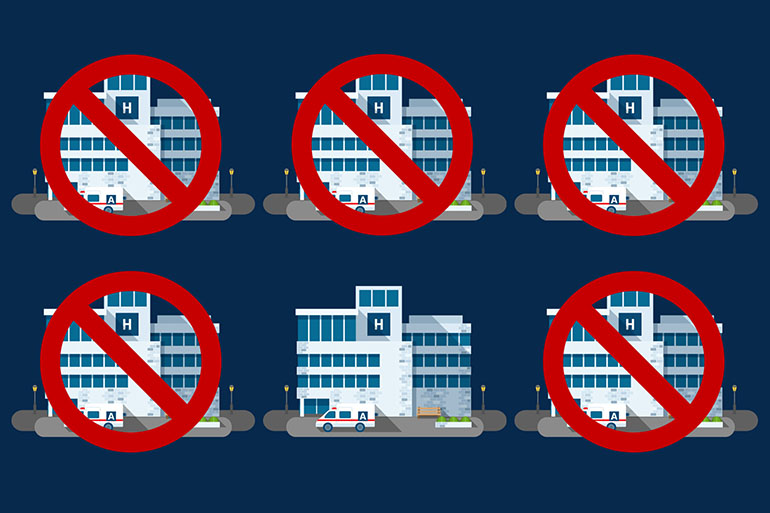Getting cancer is scary. Discovering that your marketplace plan doesn’t give you access to leading cancer centers may make the diagnosis even more daunting. As insurers’ shrink their provider networks and slash the number of plans that offer out-of-network coverage, some consumers are learning that their treatment options can be limited.
One reader wrote to Kaiser Health News last month saying that she was dismayed to learn that none of the plans offered on the New York health insurance marketplace provides access to Memorial Sloan Kettering Cancer Center in New York City, where she is a patient.
Memorial Sloan Kettering is a well-regarded cancer center that is affiliated with two key organizations: the National Comprehensive Cancer Network (NCCN) and the National Cancer Institute. It participates in New York’s Essential Plan, which is available to lower income people on the exchange, but not in any regular metal-level plans.
The National Comprehensive Cancer Network is an alliance of 27 cancer centers. Member physicians and researchers develop widely recognized clinical practice guidelines.
 Insuring Your Health
Insuring Your HealthThe National Cancer Institute recognizes many cancer centers for their scientific leadership and research. The 69 NCI-designated cancer centers can offer patients access to cutting edge treatments and clinical trials. All 27 NCCN centers are also designated by the NCI.
It’s unclear the extent to which these cancer centers, which are often but not always affiliated with large academic institutions, are included in the provider networks of marketplace plans nationwide. A survey by Avalere Health and NCCN in 2015 found that three quarters of NCI-designated cancer centers said they participated in at least some exchange plans, and 13 percent said they were included in all exchange plans in their state. However, of the 25 percent of centers that didn’t participate in any exchanges, many were in states with large numbers of exchange enrollees, including Texas and New York, the survey reported.
Does it matter if someone with a cancer diagnosis gets treatment at one of these centers rather than at a community hospital or some other site? Research suggests that it may. A study found that adult patients between the ages of 22 and 65 who were newly diagnosed with several types of cancer — breast, colorectal, lung, pancreatic, gastric and bile duct — were 20 to 50 percent more likely to die from it if they were initially treated at a non NCI-designated comprehensive cancer center. The study, which analyzed the 5-year survival rates of nearly 70,000 patients whose cancers were reported in the Los Angeles County cancer registry between 1998 and 2008, was published in the journal Cancer in 2015.
Researchers hypothesize that the cancer centers’ multidisciplinary approach to decision-making, supportive care and access to cutting-edge treatment, among other things, contribute to the superior outcomes at comprehensive cancer centers, said Dr. Julie Wolfson, a pediatric oncologist at the Institute for Cancer Outcomes and Survivorship at the University of Alabama at Birmingham who co-authored the study.
“The goal is to find out what is different about these places and then disseminate that to other” treatment sites, Wolfson said.
Often there are factors besides survival rates that contribute to patients’ decisions about where to go for care, said Dr. Robert Carlson, CEO of the National Comprehensive Cancer Network. Those include social and support systems that patients already have in place and concerns about non-medical costs, such as housing and transportation.
“Most patients, if offered the option to go to major cancer center, especially if it involves traveling, will decline it,” Carlson said.
Some cancer centers aim to give patients access to both types of facilities. City of Hope cancer center’s main academic campus is in Duarte, Calif., in Los Angeles County. That’s the best site for patients when their cancers are rare or advanced, optimal treatment isn’t clear or they could participate in a clinical trial, said Dr. Harlan Levine, the chief executive of the City of Hope Medical Foundation. But the cancer center also owns a network of 14 community cancer clinics located in southern California for patients who can be effectively treated in that setting.
City of Hope participates in two plans that are offered on California’s exchange, Blue Shield and Anthem and its physicians are in network for the exchange’s Oscar health plan. But most people don’t check access to cancer care when they shop for a plan. “Cancer is an ‘infrequent purchase’ from a marketing point of view,” Levine said. In many cases, patients don’t realize their lack of access until after their diagnosis, when it may be too late.
Cancer centers may try to work with patients to enable their treatment. “We understand that each patient has a unique financial situation and we work with our patients, especially those in active treatment, to ensure they receive the care needed and that their treatment is uninterrupted,” said Ruth Landé, senior vice president for patient revenues at Memorial Sloan Kettering. “We have Patient Financial Services representatives available to assist patients who do not have health insurance or whose insurance may not cover all charges.”
Patients who believe that it’s critical to be treated at a cancer center that’s not in their insurance network have some recourse.
When people receive a cancer diagnosis, it’s “overwhelming,” said Anna Howard, a principal for policy development at the American Cancer Society’s Cancer Action Network. “You may not be aware of the fact that if your insurance plan says you don’t have coverage at a cancer center you can file an appeal.” Appealing the insurer’s decision doesn’t guarantee success, however. “Anecdotally, we hear that it depends on the specific individual and type of cancer,” Howard said.
Please visit kffhealthnews.org/columnists to send comments or ideas for future topics for the Insuring Your Health column.








